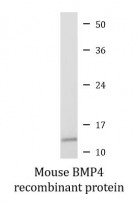ARG70185
Mouse BMP4 recombinant protein (Active) (His-tagged, C-ter)
Mouse BMP4 recombinant protein (Active) (His-tagged, C-ter) for SDS-PAGE
Overview
| Product Description | E. coli expressed, His-tagged (C-ter) Active Mouse BMP4 recombinant protein |
|---|---|
| Tested Application | SDS-PAGE |
| Target Name | BMP4 |
| Species | Mouse |
| A.A. Sequence | Lys303 - Arg408 |
| Expression System | E. coli |
| Activity | Active |
| Activity Note | Determined by its ability to induce alkaline phosphatase production by ATDC5 cells. The ED50 for this effect is < 10 ng/mL. The specific activity of recombinant mouse BMP-4 is > 1 x 10^5 IU/mg. |
| Alternate Names | BMP2B; BMP-4; OFC11; Bone morphogenetic protein 2B; BMP2B1; Bone morphogenetic protein 4; MCOPS6; ZYME; BMP-2B |
Properties
| Form | Powder |
|---|---|
| Purification Note | Endotoxin level is less than 0.1 EU/µg of the protein, as determined by the LAL test. |
| Purity | > 98% (by SDS-PAGE) |
| Buffer | 20 mM sodium carbonate (pH 4.5) |
| Reconstitution | It is recommended to reconstitute the lyophilized protein in sterile water to a concentration not less than 200 μg/mL and incubate the stock solution for at least 20 min at room temperature to make sure the protein is dissolved completely. |
| Storage Instruction | For long term, lyophilized protein should be stored at -20°C or -80°C. After reconstitution, aliquot and store at -20°C or -80°C for up to one month. Storage in frost free freezers is not recommended. Avoid repeated freeze/thaw cycles. Suggest spin the vial prior to opening. |
| Note | For laboratory research only, not for drug, diagnostic or other use. |
Bioinformation
| Gene Symbol | BMP4 |
|---|---|
| Gene Full Name | bone morphogenetic protein 4 |
| Background | The protein encoded by this gene is a member of the bone morphogenetic protein family which is part of the transforming growth factor-beta superfamily. The superfamily includes large families of growth and differentiation factors. Bone morphogenetic proteins were originally identified by an ability of demineralized bone extract to induce endochondral osteogenesis in vivo in an extraskeletal site. This particular family member plays an important role in the onset of endochondral bone formation in humans, and a reduction in expression has been associated with a variety of bone diseases, including the heritable disorder Fibrodysplasia Ossificans Progressiva. Alternative splicing in the 5' untranslated region of this gene has been described and three variants are described, all encoding an identical protein. [provided by RefSeq, Jul 2008] |
| Function | Induces cartilage and bone formation. Also act in mesoderm induction, tooth development, limb formation and fracture repair. Acts in concert with PTHLH/PTHRP to stimulate ductal outgrowth during embryonic mammary development and to inhibit hair follicle induction (By similarity). [UniProt] |
| Cellular Localization | Secreted, extracellular space, extracellular matrix. [UniProt] |
Images (1) Click the Picture to Zoom In






